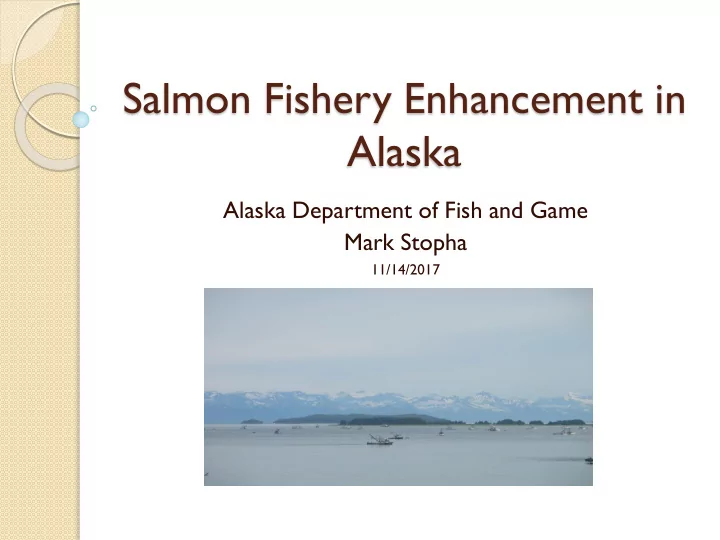

Salmon Fishery Enhancement in Alaska Alaska Department of Fish and Game Mark Stopha 11/14/2017
Today’s Presentation The state’s role at Klawock River Hatchery 1. State hatchery permitting process 2. Options for sockeye fishery enhancement 3.
Why did Alaska start it’s modern hatchery program? 140 Statewide Salmon Harvest 120 Commercial Harvest in millions of fish 100 Statehood 1959 80 60 40 20 0 1900 1905 1910 1915 1920 1925 1930 1935 1940 1945 1950 1955 1960 1965 1970
Salmon Production since 1975 300 Millions Hatchery return 250 Natural return Commercial Harvest in number of fish PNP Hatchery Program 1974 200 Limited Entry and Hatcheries 1973 FRED 1971 150 Statehood 1959 100 50 0 1900 1905 1910 1915 1920 1925 1930 1935 1940 1945 1950 1955 1960 1965 1970 1975 1980 1985 1990 1995 2000 2005 2010 2015
Why Alaska’s Hatchery Program Works Fisheries managed for wild stock escapement Most salmon habitat intact Local stocks for hatchery broodstock Selective breeding not used Large number of broodstock used Hatchery Siting
Wild Stock Protection Mechanisms Permit hatcheries at lower capacity Wild stocks priority in management Tagging/marking and sampling program Study wild/hatchery interactions 6
Alaska’s salmon fishery enhancement program is stakeholder driven Stakeholders determine fishery enhancement in each region. The ADF&G determines what is appropriate within their mandate to protect natural production. Regional Planning Team (RPT) produce a Comprehensive Salmon Plan for their region. 7
State Role in Hatchery Production Oversight of salmon hatchery production Planning- Regional Planning T eam Manage fisheries to protect wild stocks
I. State Role at Klawock Hatchery State retains ownership of hatchery Regulates hatchery production through the permitting process Manage wild stocks to meet escapement
Klawock Hatchery Site Klawock Hatchery was built in 1977 as state hatchery. The site was selected because of the large volume of water available, public road access to reduce operating costs, local labor source, potentially high biological productivity, and historic salmon decline to this system and others in the vicinity.
Klawock River Hatchery Permitting Built and operated by the state in 1978- 1992 ◦ PNP Permits City of Klawock 1993-1995 POWHA 1995-2016 Currently operated by SSRAA ◦ Currently permitted for 5 million coho salmon and 1 million sockeye eggs.
II. Hatchery Permitting Process 12
Only 2 types of permits that authorize salmon propagation in Alaska Private Nonprofit Fish Resource (PNP) Salmon Permit (FRP) Hatchery Permit 13
Fish Resource Permits (FRP’s) Permit Classifications: Collection Holding Propagation
Propagative Research Permit No more than 500,000 eggs from non- smolt species or 100,000 eggs from smolt species. Eggs are intended to produce fewer than 5,000 returning adults. All adult returns are considered common property and are not the exclusive property of the project.
PNP Hatchery Permit Non-profit entity submits application to PNP coordinator ADFG staff review app and submit comments to ADFG PNP coordinator Management Feasibility Plan developed by ADFG RPT reviews application for compatibility with regional comprehensive plan and sends recommendation to ADFG Commissioner Hatchery operation plan (called Basic Management Plan) drafted by applicant and ADFG Staff Public Hearing held for comment on hatchery Hatchery App, BMP and Public Comment submitted to Commissioner for decision
Ongoing Hatchery Permitting FTP- Fish Transport Permit ◦ Egg takes, transports, releases. AMP- Annual Management Plan ◦ Plan for the year’s egg takes, releases, harvest management
III. Sockeye Salmon Enhancement Current permitting status: ◦ 1 million eggs are on SSRAAs Klawock River PNP hatchery permit
Sockeye Production Requirements IHN virus-free water Isolation in hatchery from other fish being reared
Types of Sockeye Programs Enhancement: Adding to natural production. Rehabilitation: Renewing natural production.
Sockeye Fishery Enhancement Adds to current natural production Returns are solely for harvest and broodstock
Sockeye Rehabilitation Must know what is limiting production before adding fish to a system ◦ Limited Spawning Area? ◦ Limited Escapement? ◦ Limited Nutrients in the Lake? ◦ Poor habitat? ◦ Predators? ◦ Competitors?
Sockeye Production in Alaska Prince William Sound ◦ Main Bay Hatchery ◦ Gulkana River Southeast ◦ Snettisham Hatchery Kodiak ◦ Pillar Creek Cook Inlet ◦ Trail Lakes Hatchery
Recommend
More recommend